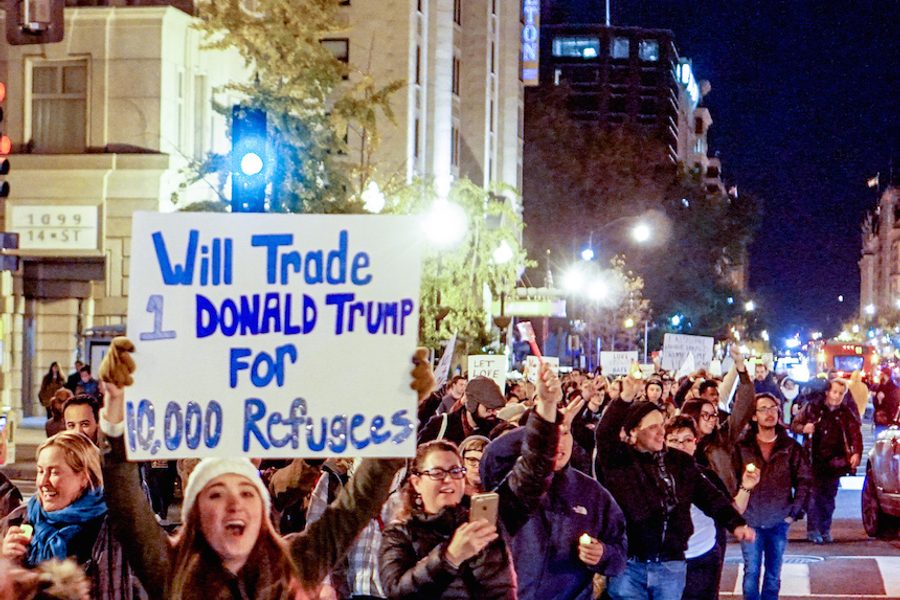Donald Trump May Have Won—But This Is No Right-Wing Revolution
What the data can tell us on what went wrong, and how to move forward.
Mike Davis

This article was first posted at Verso Books.
We should resist the temptation to over-interpret Trump’s election as an American Eighteenth Brumaire or 1933. Progressives who think they’ve woken up in another country should calm down, take a stiff draught, and reflect on the actual election results from the swing states.
Data, of course, is incomplete. The leading exit polls, like Pew and Edison, are hardly flawless in their harvesting of opinion and the final word on the turnout and its composition must await the Current Population Survey’s reports over the next year or two. Nonetheless, the county-level returns authorize some pertinent observations.
1. Turnout was initially reported to be significantly lower than 2012, but late returns indicate the same percentage of voters (app. 58 per cent) although with a smaller major party share. The minority parties, led by the Libertarians, increased their vote from 2 to 5 percent of the total.
2. With the exceptions of Iowa and Ohio, there were no Trump landslides in key states. He polled roughly the same as Romney, making up smaller votes in the suburbs with larger votes in rural areas to achieve the same overall result. His combined margin of victory in Wisconsin, Michigan and Pennsylvania combined was razor thin, about 107,000 votes.
3. The great surprise of the election was not a huge white working-class shift to Trump but rather his success in retaining the loyalty of Romney voters, and indeed even slightly improving on the latter’s performance amongst evangelicals for whom the election was viewed a last stand. Thus economic populism and nativism potently combined with, but did not displace, the traditional social conservative agenda.
4. The key factor in carrying the Republicans was Trump’s cynical covenant with religious conservatives following the primary defeat of Cruz. He gave them a free hand to draft the party platform at the Convention and then teamed with one of their popular heroes, Pence of Indiana, a nominal Catholic who attends an evangelical megachurch. At stake for right-to-lifers, of course, was control of the Supreme Court and a final chance to reverse Roe vs Wade. This may explain why Clinton, who unlike Obama allowed herself to be identified with late-term abortions, underperformed him by 8 points amongst Latina/o Catholics.
5. The defection of white working-class Obama voters to Trump was a decisive factor mainly in a lakeshore rim of industrial counties in Michigan, Ohio and Pennsylvania—Monroe, Ashtabula, Lorain, both Eries, and so on—which are experiencing a new wave of job flight to Mexico and the US South. This region is the most visible epicenter of the revolt against globalization.
In other depressed areas—the coal counties of southeastern Ohio, the former anthracite belt of eastern Pennsylvania, the Kanawha Valley of West Virginia, the piedmont textile and furniture towns of the Carolinas, Appalachia in general—the pro-Republican blue-collar realignment in presidential politics (but not always in local or state politics) was already the status quo. The mass media has tended to conflate these older and newer strata of “lost Democrats”; thus magnifying Trump’s achievement.
6. I’ve been unable to find reliable data about the turnout of non-college whites in key states or nationally. According to the dominant narrative Trump simultaneously mobilized non-voters and converted Democrats, but the variables are independent and their weights are unclear in states like Wisconsin or Virginia (which Clinton narrowly held) where other factors like Black turnout and the size of the gender gap were likely more important.
7. A crucial cohort of college-educated white Republican women appeared to have rallied to Trump in the last week of the campaign after having wavered in previous polling. This has been attributed by several commentators, including Clinton herself, to Comey’s surprise intervention and renewed skepticism about her honesty. Disapproval of Trump’s rapist behaviour, moreover, was counterbalanced by disgust at Bill Clinton, Anthony Weiner and Alan Grayson (the wife-abuser who was Rubio’s Democratic opponent in Florida). As a result, Clinton made only modest gains, sometimes none at all, in the crucial red suburbs of Milwaukee, Philadelphia, and Pittsburgh.
8. A fifth of Trump voters—that is to say, approximately 12 million voters—reported an unfavorable attitude toward him. No wonder the polls got it so wrong. “There is no precedent,” wrote the Washington Post, “for a candidate winning the Presidency with fewer voters viewing him favorable, or looking forward to his administration, than the loser.”
Many of these nose-holders may have been evangelicals who were voting the platform, not the man, but others wanted change in Washington at any price, even if it meant putting a suicide bomber in the Oval Office.
9. Even the Cato Institute seems to believe that election should be interpreted as Clinton’s loss, not Trump’s win. She failed to come close to Obama’s 2012 performance in key Midwestern and Florida counties. Despite his strenuous last-minute efforts, the president could not transfer his popularity (now higher than Reagan’s in 1988) to his old opponent. Ditto for Sanders.
Although the findings are controversial and perhaps misinterpreted by David Atkins in the American Prospect, the Edison/New York Times exit polls indicate that Trump relative to Romney achieved only the slightest improvement amongst Whites, perhaps just one percent, but “bested him by 7 points among Blacks, 8 points among Latinos and 11 points among Asian Americans.”
10. Whether or not that was actually the case, the lower Black turnout in Milwaukee, Detroit and Philadelphia alone would explain most of Clinton’s defeat in the Midwest. In south Florida a massive effort improved the Democratic vote but that was offset by reduced turnout (largely Black voters) in the Tallahassee, Gainesville and Tampa areas.
11. Not all of this diminished Black turnout, to be fair, was a boycott of Clinton. Voter suppression undoubtedly played an important if yet unmeasured role. “Some states,” reports one study, “have closed polling places on a massive scale. In Arizona, almost every county reduced polling places. In Louisiana, 61 per cent of parishes reduced polling places. In Louisiana, 61 percent of parishes reduced polling places. In our limited sample of Alabama counties, 67 percent closed polling places. In Texas, 53 percent of counties in our limited sample reduced voting locations.” There is also evidence that discriminatory voter ID requirements—the jewel in crown of Scott Walker’s counter-revolution—significantly reduced the vote in low-income precincts of Milwaukee.
12. An alternate explanation of Clinton’s underperformance in Wisconsin and Michigan was the alienation of millennial Sanders voters: in both states Jill Stein’s total was greater than the margin of Clinton’s defeat. The Green vote was also significant in Pennsylvania and Florida (49,000 and 64,000 respectively). But Gary Johnson, who won 4,151,000 votes nationally despite his cluelessness about world politics, probably harmed Trump much more than Clinton.
13. Since the 2004 insurgency of Howard Dean, progressive Democrats have fought uphill against Party regulars for a full 50-state strategy that invests in base building in otherwise gerrymandered red congressional districts. The consistent failure of the DNC, for example, to make a major commitment to Texas Democrats—a state that is now majority minority—has long been an open scandal.
The Clinton campaign, flush with funds but obviously short on brains, compounded a disastrous strategy. She failed for example to visit Wisconsin after the Convention despite warnings that Scott Walker’s fired-up followers were fully enlisted behind Trump.
Likewise she disdained Agriculture Secretary Tom Vilsack’s advice that she set up a “rural council” such as had served Obama so well in his Midwestern primary and presidential campaigns. In 2012, he managed to add 46 per cent of small town vote to his urban majority in Michigan and 41 per cent in Wisconsin. Her desultory results were 38 per cent and 34 per cent, respectively.
14. Ironically, Trump may have been advantaged by his poor backing from the Kochs and other conservative mega-donors, who switched priorities to invest in saving Republican congressional majorities. In the event Comey’s letter to Congress was the equivalent of $500 million worth of anti-Clinton ads while down-ticket Republicans received an unexpected financial lifeline.
15. My emphasis on the contingent and fragile character of the Trump coalition, however, needs to be accompanied by a warning about the toxic contents of his politics. As I’ve argued in another note, Trump is less a loose canon and opportunist than usually portrayed. His campaign systematically pushed all the buttons associated with the white-nationalist alt-right whose godfather is Pat Buchanan and would-be Goebbels is Stephen Bannon.
Trump, President Obama consoles us, is “non-ideological.” Ok, but Buchanan-Bannon have buckets of ideology and it’s called fascism. (For those who think this is an exaggeration and that fascism is passé, please go to Buchanan’s site and scroll to the list of his most popular columns. One blames Poland for the start of World War Two and another basically claims that Blacks should pay reparations to whites.)
16. David Axelrod claims that it has taken only a week for the Republicans to fully “capture” Trump and Robert Kuttner agrees. Perhaps.
Certainly Trump will attempt to honor his commitment to the Christians and give them the Supreme Court—a goal that Mitch McConnell may facilitate with the “nuclear option” in the Senate. Likewise Peabody, Arch and the other coal companies will get new permits to destroy the earth, immigrants will be sacrificed to the lions, and Pennsylvania will be blessed with a right-to-work law. And, of course, tax cuts.
But on social security, medicare, deficit spending on infrastructure, tariffs, technology, and so on, it’s almost impossible to imagine a perfect marriage between Trump and the institutional Republicans that doesn’t orphan his working-class supporters. Mortgage bankers still rule the universe.
17. Therefore it would not be difficult to imagine a future scenario where the alt-right ultimately splits with or is expelled from the administration and quickly moves to consolidate a third political force around the expanded base it has won thanks to Trump’s demagoguery. Or, another possibility, that Trump’s incendiary trade and contradictory domestic policies plunge the country into a new depression and Silicon Valley finally steps up to the plate to save the center-left Democratic Party.
But whatever the hypothesis, it must take account of the real revolution in American politics, the Sanders campaign. The downward or blocked mobility of graduates, especially from working class and immigrant backgrounds, is the major emergent social reality, not the long agony of the Rustbelt. I say this while recognizing the momentum given to economic nationalism by the loss of five million industrial jobs over the last decade, more than half of them in the South.
But Trumpism, however it evolves, cannot unify millennial economic distress with that of older white workers, while Sanders showed that heartland discontent can be brought under the umbrella of a “democratic socialism” that reignites New Deal hopes for a Economic Bill of Rights. With the Democratic establishment in temporary disarray, the real opportunity for transformational political change “‘critical realignment” in a now archaic vocabulary) belongs to Sanders and Warren. We must hurry.





